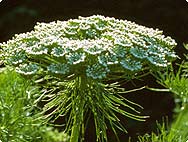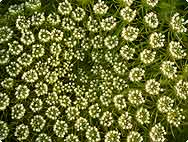A.Vogel search
When the internal search is activated, personal data such as your IP address is transmitted to our search engine Cludo. Data is thus transferred to a third country. Please click here if you want to display the internal search. You can find more information on data protection here: Privacy policy.
Ammi visnaga L.
Khella
History

Ammi originates from the Nile delta and was used therapeutically by the ancient Egyptians, as is documented in Eber’s papyrus. The plant was used in Egyptian folk medicine to treat urinary calculi and bladder stones which was common as a result of widespread bilharzia. The plant’s dried umbels are still sold today in markets in the Middle East and the Far East, where the stems are used as toothpicks.The name Ammi was used for the plant early on by Dioscorides. The word comes from the Greek term ammos meaning “sand” and refers to the plant’s habitat. The generic name “visnaga” is alleged to have developed from the term “bis acutum” meaning “doubly pointed”. Old Latin names for the plant are Cuminum alexandrium, C. aethiopicum and C. regium (referring to Alexandrine-, Ethiopian- and Royal Cumin respectively). The Arabic name, khella is used throughout the Middle East and often in Europe.Lonicerus wrote that Ammi was a hot, dry plant and could therefore be used for “cold afflictions”, claiming its effectiveness: “against irritable stomachs and for the womb; it stimulates urine and women’s cycles (menstruation).” The seeds of this plant were at one time used to treat sterility, convulsions in the urethra and kidney stones; such conditions were regarded as “cold afflictions”. All of these effects have since been confirmed by scientific research.
Botanical characteristics

This perennial and sometimes biennial plant puts out an erect, round, furrowed stem which can grow to a height of 80-120 cm. The leaves are approximately 20 cm long, greyish green in colour, jagged and finely divided. The stalk branches out at the top and is slightly arched, terminating in large umbels which branch out into often as many as one hundred different rays, from which smaller umbels of white flowers containing many petals issue forth. The rays of umbels are thick and stiff when ripe and contract into “nests”. Once they have become woody, these pleasant-tasting rays of umbels are used as toothpicks. The tiny egg-shaped, elliptical, smooth fruits decay to form two partial fruits when the plant is dry. Each of these fruits is approx. 2 mm in length and is greyish brown in colour. This plant’s inflorescence is the same as that of the carrot, Daucus carota, which is why in German-speaking countries it also bears the common name “Knorpelmöhre” (“noded carrot”). Unlike the carrot, however, the seeds of the Ammi are completely smooth; moreover the khella is hygrochasic which means that the rays of umbels open up in damp weather and close again in dry conditions. The umbellifers native to Europe are xerochasic, i.e. they open in dry conditions and close in damp weather. The plant is in bloom in July.
Habitat

Khella is native to the Mediterranean and is cultivated in Egypt, Morocco and Tunisia. There are now also large plantations in Argentina, Chile, Mexico, the southern States of the USA and the former Soviet Union.
Preparation

The fruits are harvested shortly before they are fully ripe, after which they are dried and macerated with alcohol. The resulting mother tincture is diluted by hand to achieve the required potency.
A.Vogel Blog – Natural and Healthy
Inspiration for a healthy life!




